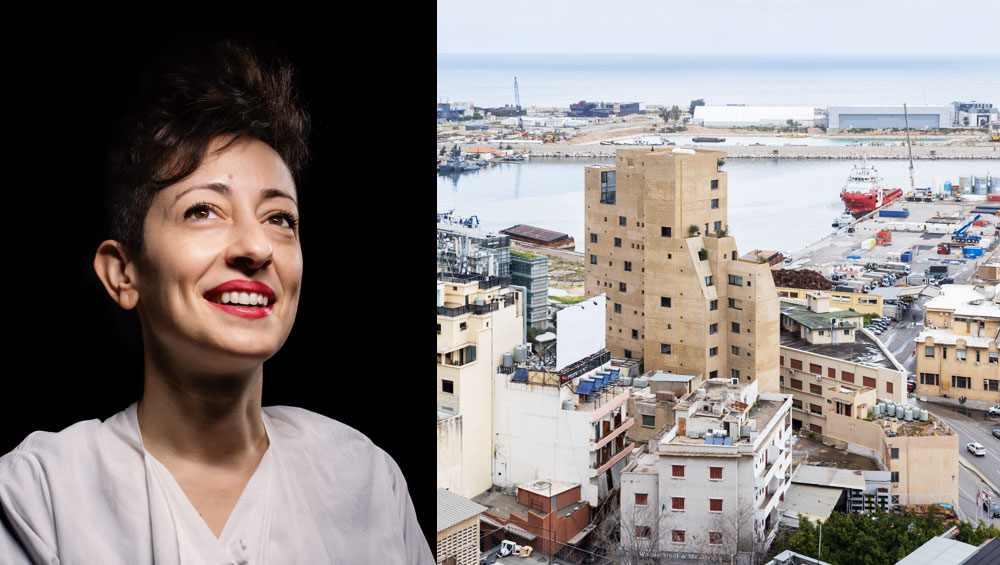
Lina Ghotmeh portrait. Photo: © Gilbert Hage. Stone Garden image © Iwan Baan.
by VERONICA SIMPSON
It has been a remarkable 12 months for the architect Lina Ghotmeh (b1980, Beirut). In spring 2020, she had just completed her first building in her hometown – Stone Garden, a striking, 13-storey apartment block of corrugated concrete, its porous facade brimming with plants. Then, in August, Beirut was struck by disaster. A major fire in the port triggered a violent explosion in a warehouse, where ammonium nitrate had been left unsafely stored for seven years; it destroyed the immediate dockside area, leaving a crater 140m wide, causing the deaths of more than 200 people and bringing about the resignation of the Lebanese government. And yet, located only a mile from the centre of the blast, Stone Garden was virtually untouched, apart from a few broken windows.
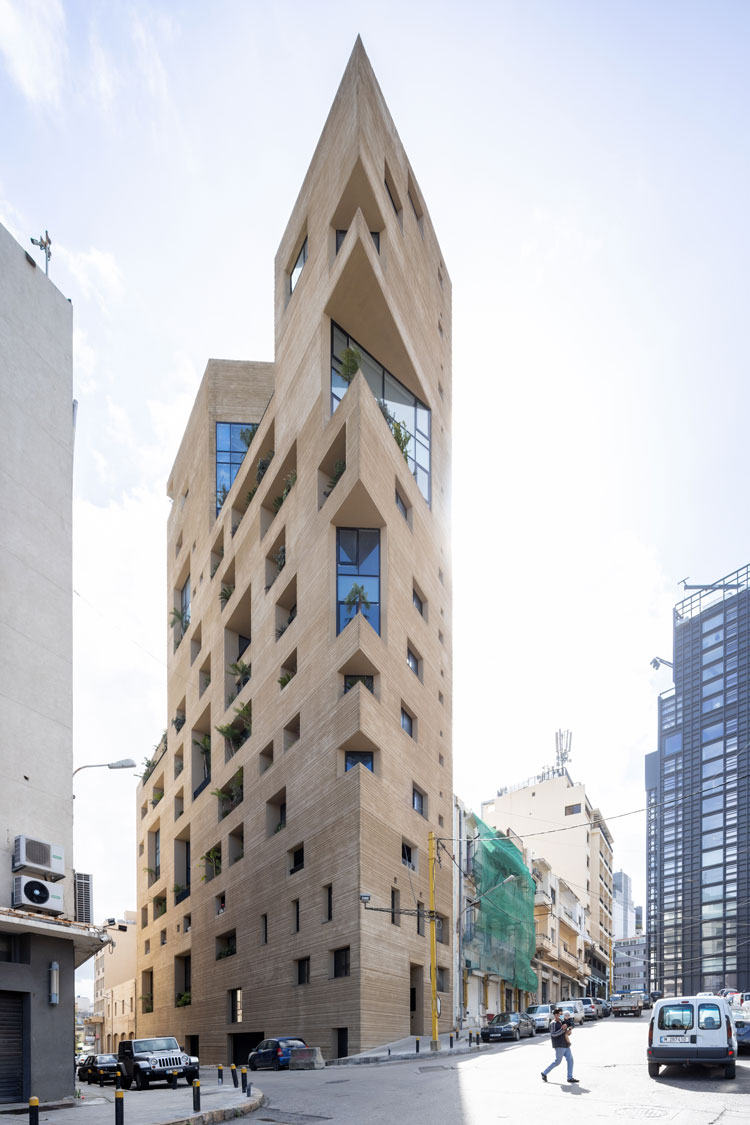
Lina Ghotmeh, Stone Garden apartment block, Beirut, 2011-20. Photo: © Iwan Baan.
The spirit of care and craft with which Ghotmeh infused this building has obvious and profound symbolism for the building and for her practice. Stone Garden was born of a friendship struck more than a decade ago between Ghotmeh and the photographer Fouad El Khoury. They shared a passion for Beirut, for photography and for El Khoury’s vision of an art foundation and archive that would capture and reflect the changing nature of the city. His family had inherited a plot from his father, the modernist architect Pierre el-Khoury, which had housed his father’s office, as well as Beirut’s first concrete factory. On the edge of the city centre – which has been vigorously and often thoughtlessly redeveloped since Lebanon’s brutal, 15-year civil war ended in 1990 - Ghotmeh conceived Stone Garden as an “inhabited sculpture”, a mass rising to the skies, its corrugated, porous concrete facade an echo of the bullet-riddled buildings of the past and the mighty rock formations along the Lebanese coast. Stone Garden, she told Domus magazine in 2019, was “an invitation not to repeat history but to cherish life and cohesion”. The abundant planting embedded in the structure is a critique of the loss of nature in the city. Stone Garden has been nominated by Archdaily as one of the Best Buildings of 2021.
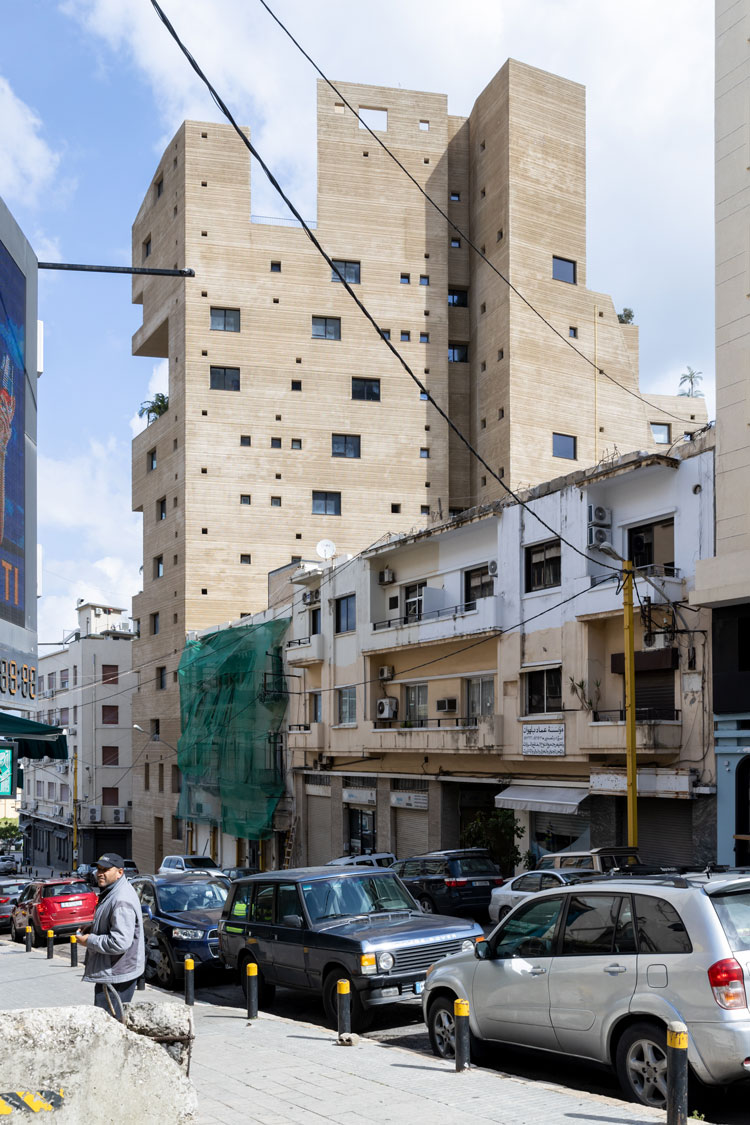
Lina Ghotmeh, Stone Garden apartment block, Beirut, 2011-20. Photo: © Iwan Baan.
Ghotmeh studied architecture at the American University of Beirut, where she developed a methodology she described as “archaeology of the future”. She completed her studies at the École Spéciale d’Architecture in Paris, later teaching there as an associate professor between 2008 and 2015. She has worked on London projects with both Ateliers Jean Nouvel and Foster & Partners. After winning the international competition for the National Estonian Museum in 2006, she co-founded the Paris-based partnership DGT Architects. The completed museum won the Grand prix AFEX 2016 and was nominated for the Mies Van der Rohe Award, 2017. In 2016, she founded Lina Ghotmeh Architecture in Paris. Current projects include the National Choreographic Centre in Tours and Hermès’ new workshop space in the Normandy countryside. Ghotmeh was awarded Woman of Outstanding Achievement, in the Tamayouz Excellence Awards 2020, which celebrate the achievement of female architects in the near East and North Africa.
Studio International caught up with Ghotmeh on Zoom in spring of 2021.
Veronica Simpson: The survival of Stone Garden creates a fascinating starting point for conversations around resilience and sustainability, especially social and cultural. But was environmental sustainability part of the brief, initially?
Lina Ghotmeh: This commission happened very early on in my practice (in 2010), before we were so aware about all the sustainability issues. It was one of my first projects almost. It was really more about its relationship with the environment of the city of Beirut and trying to get from that an understanding of what architecture can emerge on that site. Now, in my practice we are much more engaged, much more conscious of a way of constructing more thoughtfully. This was a concrete construction, and concrete is not a sustainable material. However, the fact of integrating nature as part of the architecture, that is something I intuitively felt was important - even before the trend for having greenery inside a building. It wasn’t trendy at the time. Having greenery and nature as part of our habitat gets us closer to this notion of care that we always have to give to nature. We don’t always have to separate from our environment. Also, when we do a sustainable or ecological project, one has to think about the wellbeing of the inhabitants, their relationship with the interior, the lighting: these are things of common sense, I would say. I like to implement them into a building. So, in that sense, yes, it does have this approach. And probably another side is the fact of using craft and making the building more impactful for the community and absorbing the community into its making with the notion of the crafted facade.
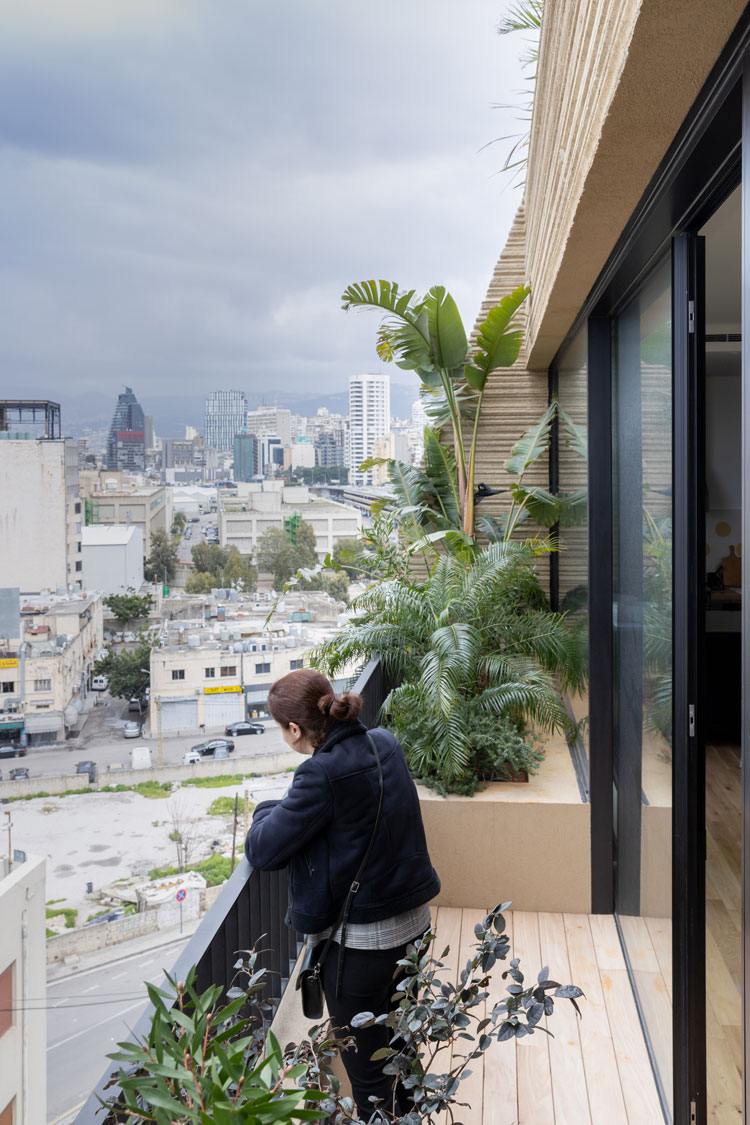
Lina Ghotmeh, Stone Garden apartment block, Beirut, 2011-20. Photo: © Iwan Baan.
VS: One of the things I really like about this building - especially in a city which has seen a lot of thoughtless speculative development - is that it does not turn its back on any aspect of this interesting site. You do have views out to sea, but also on to the fascinating patchwork around it, including a run-down hotel. It seems to embrace its neighbourhood in all its complexity.
LG: This area inspires me so much. This mixture of scale and texture is so rich. And I wanted to see how we could bring it together. There is a white hotel next to it. It’s a very modest building, but as soon as the Stone Garden was finished, the owners of the hotel you mentioned started renovating their facades so it looks like we’re protecting it and, in a way, it gives a positive impact without trying to change or gentrify its language, or the neighbourhood.
VS: The building is also designed as part of the social and cultural life of the city. Tell me how you programmed the ground floor.
LG: When I talk about the ground floor, there are two levels of ground floor because the building is on a slope. The entrance is on the lower ground floor, then you go up and you reach a double-height gallery space, the Mina Image Centre. This is a foundation dedicated to showcasing the evolution of Beirut through photography and art. So, there is an art gallery and there’s a small library adjoining that. It’s a non-profit organisation, accessible to everyone and it is directed by Fouad El Khoury, together with another curator. The El Khoury family is the owner of the land. That was part of the brief – for that part of it to be more open to the public. It becomes a place to talk about photography and art and culture.
.jpg)
Lina Ghotmeh, Stone Garden apartment block, Beirut, 2011-20. Photo: © Laurian Ghinitoiu.
VS: This seems to me a good demonstration of the fact that you can’t create excellent buildings without great clients. And because some of the apartments are also for the El Khoury family to live in, it becomes for them an emotional as well as a financial investment. Did this allow you to go further in your ambitions for the building?
LG: Definitely, the client - he is an artist, a photographer - respected my profession. He wanted to develop a project that is meaningful. That was really precious. And then also the developer who came to build the project really was amazing. He’s someone who trusted the vision for the project and went along with our experiment with the envelope as part of a very enriching dialogue. With such people, it’s possible to achieve your architectural ambitions. With the design, it took longer to convince them to push things, and we had to work more and sometimes not at the same level. I had to put a lot of myself into the project, but I think it’s worth it because I have an emotional attachment to it, too.
VS: The experiment you refer to, is that the interesting textured finish to the building? How did that come about?
LG: The building itself is a concrete structure: the whole of the building is concrete. And it was all built in situ. Once the concrete was finished, I had the idea of the rendering: I wanted the building to feel as if it’s emerging from the earth. I didn’t want the standard and repetitive industrial look of concrete. In Beirut or Lebanon, the artisans are skilled, they know how to work with all materials, and so I had the idea of producing this texture on the facade as something that could be hand-combed. I started with small models in the office, with different kinds of clay and testing the striation and then afterwards I involved the developer to make a mock-up, at one-to-one scale. It’s almost like a render, but a bit more complex in terms of its composition, as it had to be tied on to the facade. We built this comb and we started combing the facade from top to bottom. It’s a 3.5m comb held on two rails, and the artisans would just project the render on the envelope and, bit by bit, they combed the envelope by hand. It’s artisanal work, but at the same time very experimental. We are trying to somehow take advantage of the knowledge here and do something unique.
.jpg)
Lina Ghotmeh, Stone Garden apartment block, Beirut, 2011-20. Photo: © Laurian Ghinitoiu.
VS: Have you been surprised or delighted by how people have inhabited the building?
LG: Yes, I was quite jealous, in fact. I wish I had an apartment like this. Each apartment is different when you are inside and the tenants really adapted it. There has been so much creativity, and I found that really cool. Also, I felt that the greenery and the presence of nature as a frame to the outside was so important, and I realised the power of that even more when I was inside. When I was designing it, the client and developer were suggesting that maybe there was no need for (the large, integral) planters, and we should take them out. At the time, I said no, we have to keep them. But then you wonder if it’s needed or not. Now I think it’s important because it gives a much more humanistic and more humble feeling, more organic.
The funny part is how the plants were also among the things that resisted the explosion. They recovered really quickly.
VS: What aspects of the design or construction of Stone Gardens made it particularly resistant to the harbour explosion? Presumably, the deep balconies and window reveals may have helped to diffuse the blast, while the solid construction helped to stabilise the building.
LG: I haven’t analysed it, but I think it’s very interesting. I think it’s partly the fact that, as architecture, it was really all structure. Some buildings (nearby) which had cladding, when the blast happened, it just pulled off all the facades. Here, there weren’t any add-ons. The envelope stayed intact. It was the integrity of the envelope. But maybe, seeing how other buildings were completely wrecked, I’m amazed that Stone Garden has its own strengths. If you think about the edges, they’re not closed, which also allowed the force to flow through.
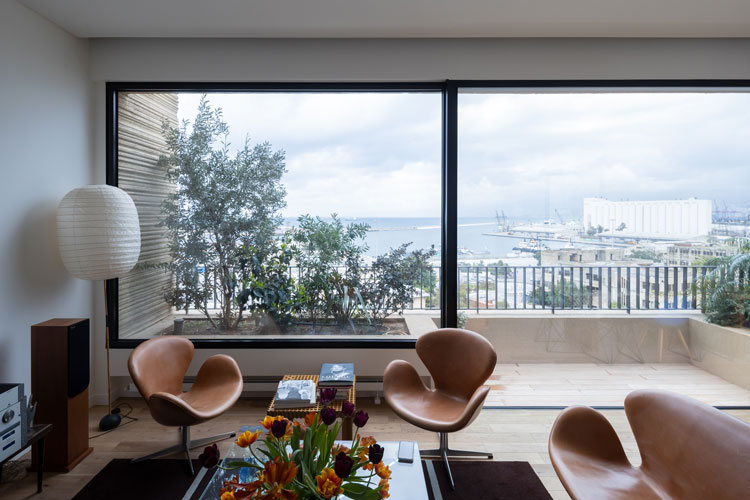
Lina Ghotmeh, Stone Garden apartment block, Beirut, 2011-20. Photo: © Iwan Baan.
VS: You have talked about the importance of architecture as a form of archaeology. You have to be sensitive to all the layers that went before – and those that might come after – your building.
LG: I like to think about archaeology because it opens one’s imagination, to think how people once lived there. Every place is unfinished. I like to tap into this sense of the unfinished. When we are working on this project, or other projects, in the office, we are always trying to decide the history of the place, but also to read the site, to push the reading of the site, its typical characteristics, its lines, the boundary: what does it mean, how does it relate to the context? Everything feels like an emergence.
VS: Maybe because you grew up in Beirut you have a more finely tuned appreciation that nothing lasts for ever – everything has to adapt. That is something I felt keenly, visiting Beirut a few years ago: so many different layers are visible as you walk around the city. This is your first building in your hometown. That must be very satisfying to create something so memorable – and durable. But it has been a long gestation, hasn’t it?
LG: Yes. We started in 2010, and I did the design at that time. Then, for two years, the project stopped and I picked it up again in 2016. For a long time, the process was stopping and starting, the making of the building and the financial set-up - finding the right developer. In a way, for me, it’s not about the quantity of projects I do, but how much I can put into one project, the meaning. It’s like my personal project.
VS: You are now based in Paris, and have worked in Brussels and London. I would imagine these are very different environments, both in terms of the professional atmosphere within architecture and the challenges and opportunities for practising. What do you feel are the key characteristics of these different cities?
LG: What I learned in Beirut was the ability to experiment, to explore the notion of impermanence, the desire to push the boundaries of what can be made. There is more artisanship and craft you can bring into architecture. Things happen through a dialogue with the developer and the workers, there is more informality in the process. It can be very frustrating at times because the planning department doesn’t have the same professionalism, but one has to have the mindset to adapt and make the best out of a situation. That gives rise to the possibility when you are a responsible architect or developer to really do things and push things in a great way. On the contrary, when working in Paris, it’s a much more regulated city, much more organised, there are rigid systems in place and the capacity of changing, that takes much longer. You have to really be patient. But at the same time, it’s a place where, thanks to these regulations, you know that things are professional, there is a level of development that is not only about the individual building, but a collective approach and a more urban approach and vision for the city. What is amazing in Paris is the presence of the mayor, the role that the mayor plays in shaping the urban fabric and developing projects that make sense for the city. That’s something you cannot find elsewhere.
VS: Has your work been able to continue, despite the pandemic and all the lockdowns?
LG: Yes, everything is ongoing. Of course, there were some delays in projects like the National Choreographic Centre in Tours, which is a public project, so the offices were closed. We are also creating a workshop for Hermès, and there were delays for a few months. But what I love about this project, that I hope we reflect in the designs, is that Hermès is like a family business, driven by certain values, and these values are infused into everything they make.
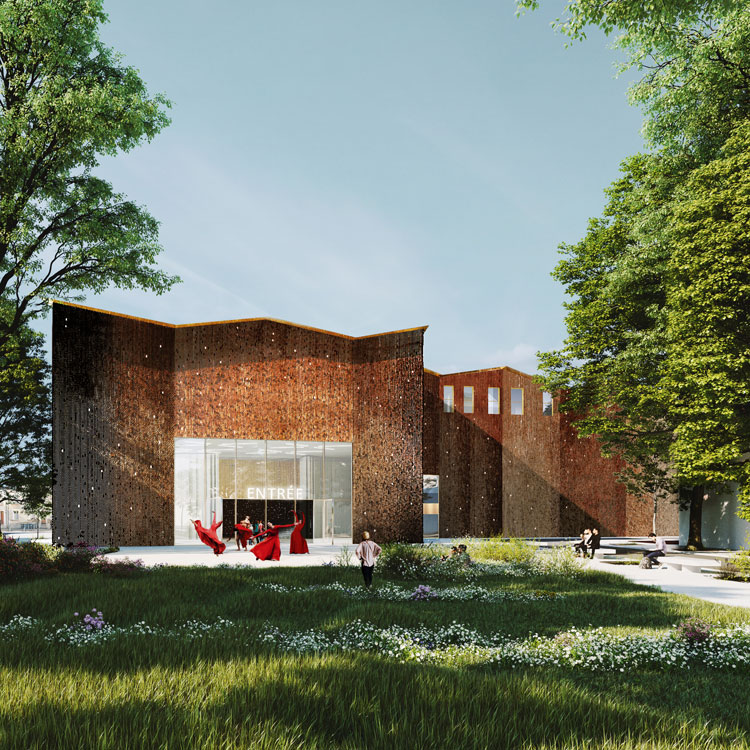
National Choreographic Centre in Tours. Photo: © Lina Ghotmeh — Architecture.
All the production (for the building) is happening in France, and they have a great ambition to make it a public building, highly ecological, very ambitious in terms of energy production, using renewable energy. Technically, it is quite an advanced project. We hope to go into the guts of the building. We are not only thinking about how it would look, we really got into the details of its making and the materials they are using and assessing its carbon footprint to be the lowest. It is also very bio-climatic.
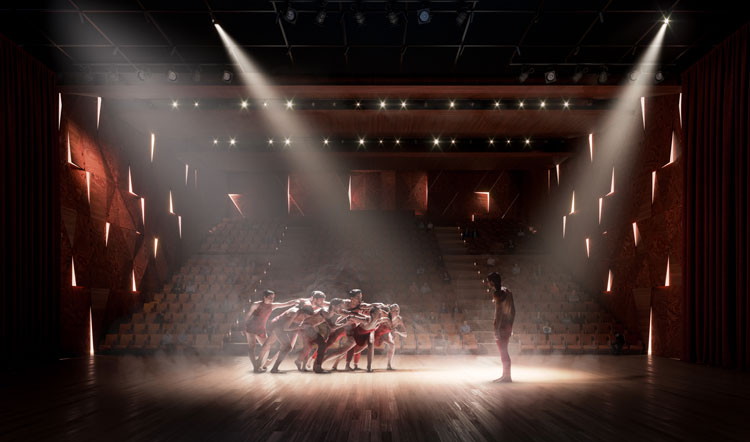
National Choreographic Centre in Tours. Photo: © Lina Ghotmeh — Architecture.
We are able to bring a kind of poetic architecture through the reading of the site and the use of materials. All the materials are locally sourced. It will be made out of brick, with the bricks made by hand in a place that is not far from the site, made out of the earth of the site itself. There is a whole circular economy, and it revives that small brick industry. What I realise also in the construction there, thanks to knowledge they acquired from recent excavations, that there had been a saddle-maker there before.
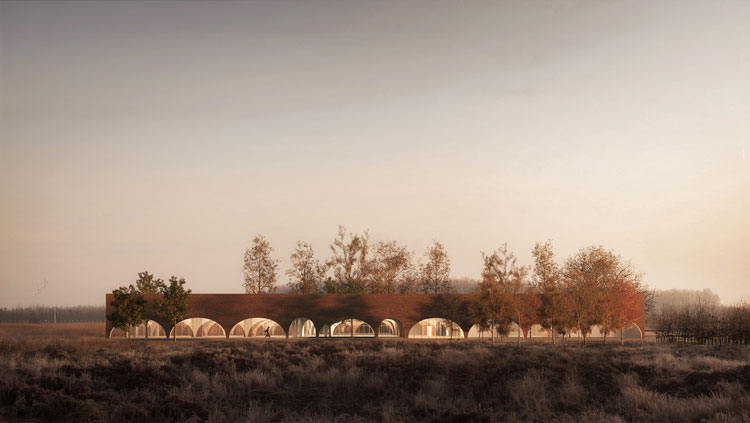
Ateliers Hermès. Photo: © Lina Ghotmeh — Architecture.
VS: And, of course, Hermès’ origins are in saddle-making, and fine leather goods. (The company was founded in 1837 by Thierry Hermès, originally as a harness workshop.)
LG: I love this fact, because sometimes I wonder whether I am constructing something new or revealing what was already there. They discovered the early culture of the site, and they found a horse jaw and a leather binding. Maybe I feel sometimes places have energy and we always tend to think we are very rational beings, but we forget that we have other senses, and things happen for reasons … in different geographies and in response to different energies. We have to build with that in mind.